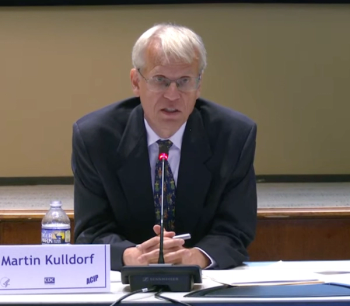
House Republicans rip prospect of Medicare drug price negotiations
Democrats say their objections are the bidding of big pharma.
With Medicare drug price negotiations, the federal government is making an offer that pharmaceutical companies can’t refuse, but that harms patient health, one legislator said.
But big pharma rakes in billions of dollars to spend on executives, shareholders, and advertising, as millions of Americans struggle to afford needed medications, another lawmaker said.
The drug price policies of the federal Inflation Reduction Act (IRA) were the subject of a Sept. 20 hearing of the
Last month, the
The U.S. Centers for Medicare & Medicaid Services (CMS) is staging “so-called negotiation … not a true negotiation,” said subcommittee Chair Rep. Morgan Griffith (R-Virginia). He referred to “The Godfather,” the popular novel and movie series about organized crime.
“It is a 'Godfather,' mafia-style negotiation where bureaucrats at CMS make companies an offer they ‘can not refuse,’” Griffith said. Drug companies must accept the government’s offered prices or lose access to Medicare, Medicaid, and the Children’s Health Insurance Program, which control almost 40% of legal drug sales in the nation, he said.
In the last year, there have been at least two dozen announcements from pharmaceutical companies halting research, “terrible news for patients in need of hope,” said Energy & Commerce Committee Chair Cathy McMorris Rodgers (R-Washington).
“Each one of these doleful announcements represents a window of hope closing hope for many patients, families, and caregivers,” she said.
Is it constitutional?
Griffith and Rodgers noted pharmaceutical companies are challenging the constitutionality of the IRA’s procedures for negotiating prices for medicines.
But it is absurd to claim a constitutional right to charge out-of-control, take-it-or-leave-it prices for prescription drugs, said Rep. Kathy Castor (D-Florida), ranking member of the subcommittee.
“For decades, big pharma has peddled the canard that exorbitantly high prices are necessary to support research and development,” she said. “But the truth is that soaring profits, huge marketing budgets and generous shareholder returns far exceed what the pharmaceutical companies invest in R and D (research and development).”
Republicans don’t care about innovation, but are simply doing the bidding of pharmaceutical companies concerned only with making money, said Rep. Frank Pallone (D-New Jersey), ranking member of the committee. He called for an expansion of drug price dickering to benefit patients using private insurance.
The representatives received written testimony and heard from witnesses in person in the hearing, also webcast live online.
Patients over policy
The IRA will overturn parts of the 1984 Hatch-Waxman Act, which has market provisions that affect drug prices and made the United States the undisputed global leader of medicinal research, said John Czwartacki, chairman of the nonprofit patient advocacy group Survivors for Solutions.
A former press secretary for a U.S. representative, Czwartacki described his 1993 diagnosis of multiple sclerosis and how his life improved due to innovative disease-modifying treatments developed since then.
“But it’s safe to say that while you all debate and make policy choices, there are patients, real patients, downstream of those choices,” Czwartacki said. “You need to understand the lives you change with the policies you create.”
‘Crushing effect’
The IRA will change the time affecting patents, generic drugs, and Medicare pricing from 13 to nine years, slashing the time to get a return on investments in developing new medicines, said Steve Potts, PhD, MBA, chair of the drug development council of the International Cancer Advocacy Network. Potts discussed how investors are shying away from small molecule drugs that take time and money to research, but that can be incredibly helpful for patients with cancer and other diseases.
“The trend is already clear. The cancer of the IRA nine vs 13 small molecule penalty will continue to metastasize, eliminating previously promising drug programs in cancer, neuroscience, orphan diseases, and many other areas,” Potts said. “I can’t imagine that there is anyone in this room who deliberately designed IRA to have this kind of crushing effect on small molecule drug development, but this is the reality. I wish it didn't take as much money as it does to develop a new drug, but that is also a reality.”
Orphan drugs at risk
Just a few rare diseases are well known to the wider public, but en masse, they affect almost 30 million Americans, a public health crisis, said John F. Crowley, executive chairman of Amicus Therapeutics. His journey into health care began when his daughter and son were diagnosed with Pompe disease, a neuromuscular disorder.
The nation is at the dawn of a new golden age of genetic medicine. Yet the IRA is punishing small biotech companies developing treatments for rare diseases, Crowley said.
He cited the 1983 Orphan Drug Act that gives tax credits for companies developing those treatments, known as “orphan drugs.” Those medicines are exempt from IRA price caps if they treat a single rare disease, but not if they treat multiple rare conditions.
“That’s a big problem,” Crowley said, because it suppresses “follow-on” research to see if a new drug will treat multiple conditions.
“In short, the IRA’s negative treatment of orphan products is a direct contradiction of the positive, and life-changing, work done by Congress in passing the Orphan Drug Act itself many years ago,” Crowley said.
Fair market conditions?
There are plenty of ethical and economic arguments against drug companies delaying the marketing of new medicines, said Aaron S. Kesselheim, MD, JD, MPH, a professor of medicine at Harvard Medical School.
Prescription drug spending has increased from $427 billion in 2015 to $634 billion in 2022, with brand-name drugs accounting for about 10% of prescriptions but 80% of spending, he said.
“These high prices are not indicators of the workings of the free market or a mechanism for innovation to reach patients, but of a system that allows manufacturers to freely set and raise prices while preventing effective competition – an arrangement nearly unprecedented in the world of government purchasing for nearly everything else,” Kesselheim said.
It is true that it takes time and money to create and test new medicines. Then manufacturers get long periods of market exclusivity, and then use numerous additional patents on formulations, methods of use, manufacturing process, and devices to block competition of generic versions for years, Kesselheim said.
Newsletter
Stay informed and empowered with Medical Economics enewsletter, delivering expert insights, financial strategies, practice management tips and technology trends — tailored for today’s physicians.















